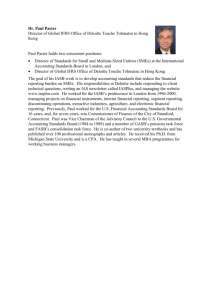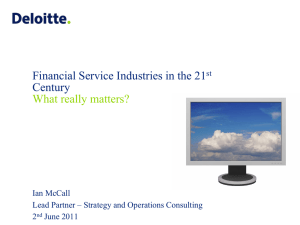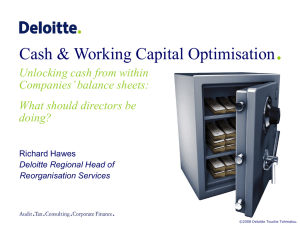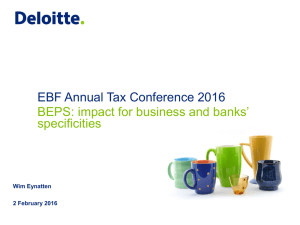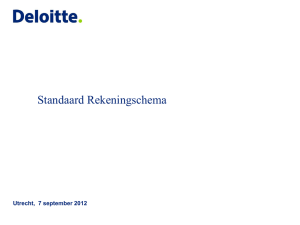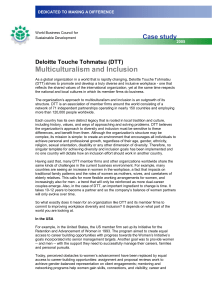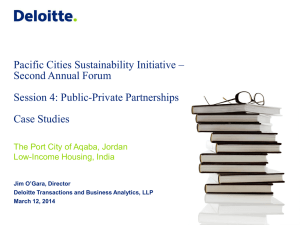CQD_Modelling Credit Risk_09042010_v1
advertisement
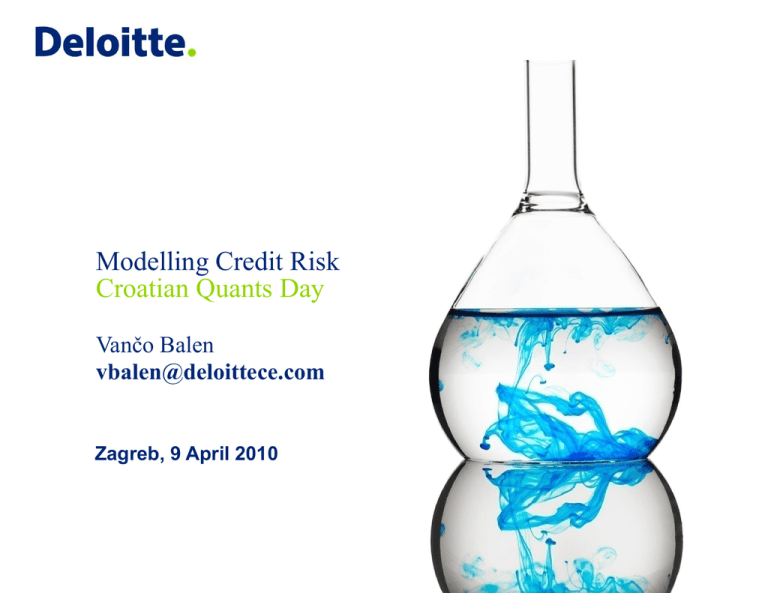
Modelling Credit Risk Croatian Quants Day Vančo Balen vbalen@deloittece.com Zagreb, 9 April 2010 Agenda 1. Risk management in banking 2. What is Credit Risk? 3. Modelling Probability of Default (PD) 4. Conclusion 2 9 April 2010 © 2008 Deloitte Touche Tohmatsu Risk Management in banking Business case of the banks: intermediaries between lenders and borrowers financial instruments transactions other services Balance Sheet Assets Basel 2 Credit Risk 80% Market Risk 12% Operational Risk 8% Other risks ??? Exposure to risks Liabilities Risks Equity Pillar 1 Pillar 2 Need for regulation Managing risks Quantitative aspects (measurement) 3 9 April 2010 Qualitative aspects (governance) © 2008 Deloitte Touche Tohmatsu What is Credit Risk? … and how to describe it analytically… Definition: Credit risk can be defined as risk of loss arising from inability of the contractual party to partially or fully fulfil its contractual obligations Process: 1. Payment of contractual obligations – risk of non-payment 2. In case of non-payment legal prosecution – recovered amount Uncertainty Probability of Default (PD) Loss Given Default (LGD) • assumes concept of Default • simplified definition: borrower stops to pay its obligations • in practice: 90 DPD or Unlikely to Pay • binomial event (0/1) • customer oriented • focus on credit quality, that is ability to repay • recovery rate • models percentage of exposure that will be lost under assumption that default has occurred • based on facility Expected loss (EL) 4 Loss 9 April 2010 = PD X LGD X Exposure at Default (EAD) • credit conversion factor is modelled - percentage of usage of credit limits (e.g. revolving, overdrafts, unused credit lines etc.) EAD © 2008 Deloitte Touche Tohmatsu Modelling Probability of Default (PD) Introduction Definition: Probability that counterparty will satisfy default definition within predefined time horizon (e.g. 1 year) Binomial event: Default flag (0/1) is target (dependent) variable Loan application (retail) 0 = Performing Financial statement (corporate) 1 = Default T T+1 time We do not model which client will default, but rather what is probability that observed client (with certain characteristics) will default! ‒ client' s characteristics = independent variables that predict probability of default (i.e. dependent variable) ‒ idea: PDi = f(X1,i , ..., Xk,i ) ‒ task: to estimate functional relationship f What characteristics we expect from the model: ‒ good predictive power - to separate good from bad clients ‒ good calibration - to estimate “level of risk” with adequate precision 5 9 April 2010 © 2008 Deloitte Touche Tohmatsu Modelling Probability of Default (PD) Example of client’s characteristics that influence credit quality Retail Corporate Financial statements (i.e. financial indicators): Size (Total assets, Total Sales, …) Profitability (EBIT/Assets, ROE, Profit margins,…) Liquidity (Current ratio, Quick ratio, …) Growth (1 year Sales growth, …) Leverage (Debt to Equity, …) Qualitative questionnaires (i.e. qualitative information about company): Quality of financial statement Quality of management Market position Relationship with the bank Socio-Demographic variables: Age Number of children Marital status Economic variables: Level of education Occupation Years of employment Financial variables: Monthly salary Salary averages Stability variables: Number of years: At current address On current job Behavioural variables 6 Number of sent payment notices Days of delay Average monthly inflow on giro account (in last quarter, year, etc) Utilization of approved credit lines etc. 9 April 2010 © 2008 Deloitte Touche Tohmatsu Modelling Probability of Default (PD) Methodological approach Task: to estimate functional relationship PDi = f(X1,i , ..., Xk,i ) Regression models - most common used apporach in practice ‒ academic example: linear reggresion – can't work (binomial event!) ‒ logit and probit models Logit model (used in practice): PDi 0 1 x1i k xki score ln 1 PDi PDi 1 score PDi ln 1 e score 1 PDi odds - ratio of bad and good Parameters estimation – e.g. MLE method; In practice usage of statistical tools (e.g. SAS, Matlab) 7 9 April 2010 © 2008 Deloitte Touche Tohmatsu Modelling Probability of Default (PD) Summary End result: Rating model which based on client's characteristics estimates probability of default (PD). Final step is aggregation of counterparties with similar PD levels in rating classes (example: S&P, Moody's,…) Rating class is characterized by assigned PD (e.g. S&P’s AAA - PD from 0% to 0,03%) Example: from 10000 counterparties with AAA rating not more than 3 are expected to default in the given time horizon (e.g. 1 year) Portfolio Scoring PD & Rating classes 1000 Client characteristics Calibration and segmentation to rating classes 100% D Rating/Scoring model 0 0 AAA Biggest challenge in practice – data: IT architecture design, record keeping, data management and data quality experience shows that many problems emerge from unsatisfactory quality and availability of data models are as good and accurate as are the data on which they are developed preparation of raw data are extremely time consuming 8 9 April 2010 © 2008 Deloitte Touche Tohmatsu Conclusion Beyond mathematics Usage of models: loan pricing loan underwriting regulatory capital calculation loan loss provisions calculation Margin 3% Credit risk 2% 10% Borrowing cost 5% How to become good Credit Risk modeller – wide range of skills and expertise needed: Mathematical and statistical knowledge Programming skill set (SAS, Matlab, SQL, ...) General IT knowledge (DW, data management, …) Economics and Finance Understanding of Regulation Banking processes Soft skills 9 9 April 2010 © 2008 Deloitte Touche Tohmatsu 10 9 April 2010 © 2008 Deloitte Touche Tohmatsu
